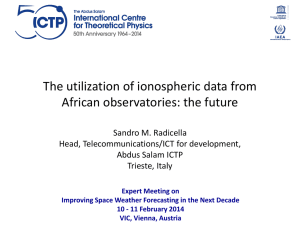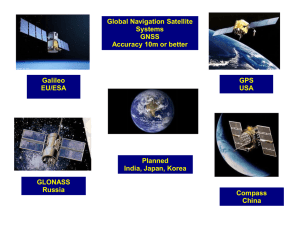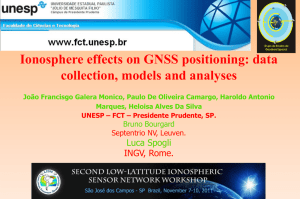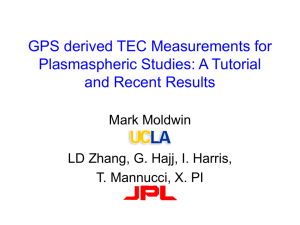RealTime_WG_splinter_meeting_point_on_RT_global_iono
advertisement
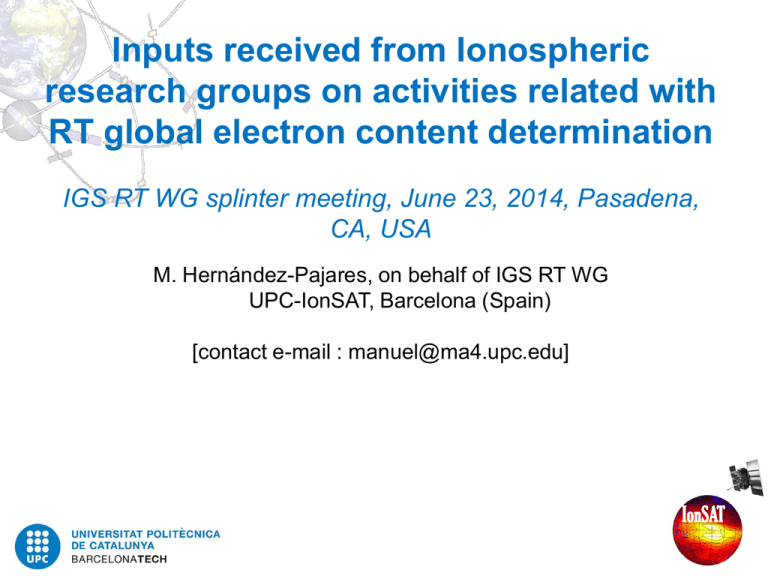
Inputs received from Ionospheric research groups on activities related with RT global electron content determination IGS RT WG splinter meeting, June 23, 2014, Pasadena, CA, USA M. Hernández-Pajares, on behalf of IGS RT WG (1) UPC-IonSAT, Barcelona (Spain) [contact e-mail : manuel@ma4.upc.edu] IonSAT Inputs received so far from Iono. res. groups on RT VTEC • DGFI, Munich, Germany: currently working on near-real time global VTEC maps using Kalman filtering. Highly interested on participating in the initiative of a RT global VTEC IGS-combined product. • NOAA, Boulder, USA: running a physics based coupled thermosphere ionosphere plasmasphere electrodynamics (CTIPe) model using inputs from ACE for a few years now. (every 10 minutes, about 20 minutes ahead of real-time). • ROB/STCE, Brussels, Belgium: ROB-IONO software delivers in NRT vTEC maps and their variability over Europe, with a latency of ~3 min. • IGG/AOE, Wuhan/Beijing, China: new approach (SHPTS) for improving the performance of GIM generation by integrating global & local ionospheric TEC models (in postprocess so far). • UNLP, La Plata, Argentina: La Plata model estimating E, F1, F2 & top-side ionospheric layers over SIRGAS-CON: RT expected (100/300 RT rec.) • UPC-IonSAT, Barcelona, Spain: generating RT (latencies of less than 30 IonSAT sec) & near RT (latencies of less than 20 min.) global electron content since 2011.5 (see previous presentation). DGFI RT-VTEC activities Currently there is an initiative at DGFI which aims to continuously estimate and publish real or near-real time global VTEC maps. The global VTEC is represented by a set of coefficients for a series expansion in terms of twodimensional base functions defined by the tensor product of polynomial Bsplines for latitude and trigonometric B-splines for longitude. We use a constrained Kalman filter to estimate the global B-spline coefficients together with satellite and receiver DCBs using real time data streams from IGS. An extensible software has been developed which provides a framework for both integrated and recursive estimation of ionospheric state parameters. Time varying characteristics of the ionosphere are modelled by using Gauss-Markov process, random walk or IRI driven evolution models. The software can also be extended to assimilate other ionospheric observables such as altimetry and occultation data in the future. The current implementation can publish real time VTEC maps at specific periods or intervals such as 5-15 or 30 minutes. Preliminary results of the study are expected to be presented at the URSI 2014 conference. A fully operational implementation for real time processing is planned to complete at IonSAT latest at the end of 2014. NOAA RT-VTEC activities NOAA have been running a physics based coupled thermosphere ionosphere plasmasphere electrodynamics (CTIPe) model using inputs from ACE for a few years now. The model results are posted on the web every 10 minutes, about 20 minutes ahead of real-time. Model results and TEC comparisons with DLR, GAIM and US-TEC are displayed here: http://helios.swpc.noaa.gov/ctipe/teccomp.html IonSAT ROB/SCTE RT-VTEC activities (1/3) The Solar Terrestrial Centre of Excellence (STCE, http://www.stce.be/) is involved in the daily management of the EUREF Permanent GNSS Network (EPN) and takes advantage of these dense GNSS observations to monitor the ionosphere over Europe from the measured delays in the GNSS signals. For that, we developed a software called ROB-IONO which analyses the GNSS data from ~110 stations of the EPN providing real-time data streams. The ROB-IONO software delivers in NRT vTEC maps and their variability over Europe. The maps are updated every 15 minutes on a 0.5°x0.5° grid extended from -15° to 25° in longitude and 35° to 62° in latitude. The maps are available online with a latency of ~3 minutes at ftp://gnss.oma.be as IONEX files and interactive web pages are displayed at www.gnss.be. IonSAT ROB/SCTE RT-VTEC activities (2/3) ROB is now maintaining a public data base with identified ionospheric events since 2012. Consequently, ROB-TEC together with variability maps estimated in NRT permit to follow the ionospheric behavior in more details, bringing valuable information during a disturbed period. Presently, more than 30 events of abnormal ionospheric activity have been reported at the www.gnss.be for the period 2012-2014. The Space Weather origin of each event is provided in collaboration with other STCE members of the Solar physics team. For the period 2012-2014, the ionospheric perturbations are associated with coronal mass ejections (~70% of the time), not well established origin of active geomagnetic conditions (~20% of the time) or unidentified phenomena (10% of the time). IonSAT ROB/SCTE RT-VTEC activities (3/3) IonSAT IGG/AOE VTEC activities (1/3) IGG (Institute of Geodesy and Geophysics, Wuhan, China) and AOE (Academy of Opto-Electronic, Beijing, China) have been developed a new approach, namely SHPTS, for improving the performance of GIM generation by integrating global and local ionospheric TEC models based on the principle of improved DADS. In the proposed method, the global and local variations of ionospheric TEC are represented by spherical harmonic and generalized trigonometric series functions, respectively. Based on SHPTS, the ionospheric TEC at each grid point covered by real GNSS data is estimated by corresponding station-based local model, and for the grid points not covered by real data the TEC is estimated by the global model. The subtle variation of ionospheric TEC can be generally captured more efficiently by the local ionospheric TEC model. Therefore, the accuracy of ionospheric TEC estimates over the real-data covered area in SHPTS is higher than that from current IAACs, whereas the accuracy of ionospheric TEC estimates over the area not covered by real data performs at the same level of current IAACs. The software for automatically processing of GIM based on SHPTS has been developed and the GIM and DCB from 2001 to 2012 have been produced from global distributed GNSS data. The DCB estimates in satellite and receiver have been validated by the corresponding products released by current IAACs. The performance of SHPTS-based GIM has been validated by the ionospheric TEC derived from raw GPS data, TOPEX/Poseidon satellite and DORIS. The GIM from current IAACsIonSAT are also introduced for comparison. IGG/AOE VTEC activities (2/3) Validation results show that (1) the accuracy of DCB in satellite and receiver estimated by SHPTS is at the level of better than 0.15ns and 1.0ns respectively, which are equivalent to that released by current IAACs; (2) the SHPTS-based GIM has the same accuracy with those released by current IAACs in the global scale and the differences of GIM among CODE, ESA, JPL, UPC and IGG is about 4.0-6.0TECu, IGG denotes the GIM generated using the proposed SHPTS method; (3) the accuracy of GIM over the areas with contributing stations covered areas has been improved significantly (better than 2 TECu relativing to the GPS-based ionospheric TEC) by introducing a set of local ionospheric TEC models established in a station basis. Therefore, SHPTS presents the advantage of using the ionospheric TEC observables from local stations to improve the accuracy of GIM, in an efficient multi-scale approach, and the performance of SHPTSbased GIM and DCB would be further improved with the increase of global IGS stations and the development of multi-GNSS. This approach has been contributed to generating the global ionospheric map for iGMAS (international GNSS Monitoring and Assessment Service, Beijing, China).The related products, including local ionospheric TEC model, global ionospheric TEC model, GIM and DCB estimates in satellite and receiver, will be available on our webs site or FTP site at October this year. Corresponding: Zishen Li, lizishen@aoe.ac.cn, lizishen@whigg.ac.cn IonSAT IGG/AOE VTEC activities (3/3) SHPTS: Towards a new method for generating global ionospheric TEC map based on Spherical Harmonic(SH) and Generalized Trigonometric Series(GTS) functions (Zishen Li, Yunbin Yuan and et.al) The global and local ionospheric TEC is modeled by SH and GTS functions and then are integrated to generate the global map based on DADS approach [Yuan and Ou(2002)]. VTEC ( , ) P (sin ) A cos(m ) B sin(m ) nd max n n 0 m 0 nmax mmax nm nm nm kmax VTEC , h Enm 0 h m Ck cos(k h) S k sin(k h) n0 m0 n k 0 The subtle variation of ionospheric TEC can be generally captured more efficiently by the local ionospheric TEC model. Performance validated by the TEC from ground stations Performance validated by the TEC TOPEX/Poseidon satellites UNLP VTEC activities (1/2) Not long ago, the IAG Sub-Commission 1.3b called SIRGAS (Sistema de Referencia Geocéntrico para las Américas) i.e. the Regional Reference Frame for Central and South America, operates a service for computing regional ionospheric maps based on the GNSS observations provided by its Continuously Operating Network (SIRGAS-CON). Since 2008, a continuous time series of maps describing the vertical Total Electron Content (vTEC) distribution for the SIRGAS region, with time resolution of one hour, is available at the SIRGAS web page: www.sirgas.org The ionospheric model used by SIRGAS, known as La Plata Ionospheric Model (LPIM), has continuously evolved from the initial “thin layer with equivalent vTEC” simplification, to the present formulation in which the E, F1, F2 and top-side ionospheric layers are considered, and their vertical electron density (ED) distributions are approximated with Chapman functions. IonSAT UNLP VTEC activities (2/2) The model parameters are estimated based on the geometry free observable computed from dual frequency carrier phase observations collected from either, ground-based or space-borne GNSS receivers on low Earth orbiting satellites (e.g.: SAC-C, GRACE, FORMOSAT-3 /COSMIC). Satellite and receivers IFB are also estimated together with the function parameters. The number of SIRGAS-CON stations with RT capabilities has steadily grown in the last years, so that today, almost 100 of the 300 stations have this capability. The distribution these stations is not homogeneous enough to allow the computation of RT ionospheric maps for the entire continent. Despite this, and in view of the fast improvement in both the number and coverage of RT stations, SIRGAS is adapting its model to RT computation. IonSAT UPC-IonSAT RT-VTEC activities (1/3) RT-TOMION: Computation of global VTEC maps based on GNSS data From each obs. we get one STEC value: V=S/M=(LiBi)/M.[~1500 val. / 30 sec] Interpol. by Splines Kriging Interpolation Layout summarizing the global VTEC computation from ground GPS data by means of the UPC TOMION software, including the main tomographic equation solved for (data: ionospheric combination of carrier phases LI , and length intersection within each voxel, ∆li; unknowns: its ambiguity BI, the STEC, S, which includes the mean electron density within each given voxel, Ne,i). New VTEC maps IonSAT UPC-IonSAT RT-VTEC activities (2/3) UPC RT-global VTEC assessment with JASON2 vs. Time: Rel.Error 2014 Global RT performance for RT is clearly worse (vs. JASON2, see plots), with Rel.Error of 20-30% in the last weeks (40100% worse than the best IGS VTEC maps, the rapid UPC at 15 min UQRG) IonSAT UPC-IonSAT RT-VTEC activities (3/3) URTG assessment over Europe 2014 RT performance only slightly worse over Europe during this year (vs. JASON2, see plots), with Rel.Error of 10-20% in the last weeks (between 0 to almost 100% worse than UQRG). IonSAT

